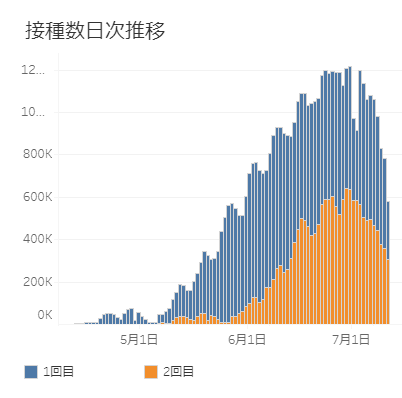In the spring of 2021 Japan was running about 4 months behind the US and much of Europe vaccinating its population against Covid-19. Vaccinations for senior citizens did not start ramping up significantly until May when other countries had started in December 2020 or January 2021.
After Israel and then the US decided to go for 3rd shots to boost immunity after antibody levels dropped months after 2nd shots of Pfizer and Moderna, Japan also negotiated for booster shots from Pfizer and Moderna. The government went for an 8-month interval and planned for 3rd shots for healthcare workers from December 2021 and the general population from January 2022, with eligibility starting 8 months after the second shot.
Then came Omicron which significantly escapes immune system responses from antibodies. Without boosters protection against symptomatic infection drops significantly with this new variant, as it takes a much higher concentration of antibodies in the blood serum to achieve sterilizing immunity. Long term T-cell immunity, which still protects against hospitalization and death, is much less affected.
In the city of Setagaya, Tokyo where I live, those who have received their second dose at the end of June will receive tickets by the end of January that will allow them to make vaccination appointments some time in February. So far no date has been announced for the group I’m in but having received my shots in July, I probably won’t be getting those tickets before late February and no booster appointment before March. It’s going to be a very long three months when some European countries are expecting to be Omicron-dominated by Christmas, within 4 weeks of the WHO having awarded B.1.1.529 its new name!
Japan is talking to Pfizer about moving part of the 78 million booster doses due for delivery in Q1 2022 forwarded so they can be dispenses sooner. However, former vaccine czar Kono Taro recently pointed out on his personal blog that Japan has enough leftover vaccines still in stock to give 56 million booster shots without waiting for any supplies from Pfizer or Moderna.
In order to protect the public from the new coronavirus, efficiency and speed are more important than equality and fairness.
Some people say that if the vaccine is brought forward, the supply of the vaccine will not be sufficient in time.
At present, Pfizer and Moderna have about 10 million doses of vaccine in stock in the market.
There may be a few doses that have been discarded, but there is no way that 1 million doses were discarded.
In addition, 4 million doses of Pfizer have already been distributed to local governments.
Another 12 million doses of Pfizer will be distributed next week and the week after.
In addition, we have 15 million doses of Moderna in stock for this year, and since the third dose of Moderna is only half the amount of the first and second doses, we will need 30 million doses for the third dose. This will be 30 million doses.
This means that 56 million doses of vaccine could be distributed by the end of the year.
In the first quarter of next year, Pfizer will distribute 30 million doses and Moderna will distribute 24 million doses. In the first quarter of next year, Pfizer will receive 30 million doses, Moderna will receive 24 million doses, and the third dose will be 48 million doses, for a total of 7.8 million doses. In the first quarter of next year, Pfizer will receive 30 million doses, Moderna 24 million doses, and 48 million doses for the third dose, for a total of 78 million doses.
(3回目のワクチン接種, 2021-12-09 [translation by DeepL])
The Japanese government can not blame a slow booster vaccination campaign on a lack of supplies. It needs to act as quickly as possible. The day before yesterday, Germany gave about 1.3 million booster shots in one day.
While officially no community spread of Omicron has been detected in Japan yet, that may simply being because they are not looking for it hard enough.
On Wednesday, 2021-12-15 the Philippine government reported its first Omicron case, a Philippine resident of Japan who had arrived from there on December 1 and tested positive. He had symptoms of a cold at the time. After the positive test the sample was sequenced and determined to be Omicron. This suggests that most likely Omicron was already circulating within Japan two weeks ago. Regardless, it will officially be here very soon.
Once it hits the hospitals, many nurses and doctors are likely to get infected and may have to quarantine. As of today, only about 149,884 of about 5 million healthcare workers (about 3 percent) who had been fully vaccinated have received a third shot. That’s after two weeks of booster campaign. 97 percent are yet to receive their booster. Only 0.11 percent of the Japanese population have received a 3rd shot. In many European countries it’s 20 percent and more.
The vaccination of the elderly is not even due to start until another two weeks from now. There are 52 million people in Japan who have received two doses and are age 50 or above. We should use the doses that we have now as soon as we can.
We really have no time to lose.

